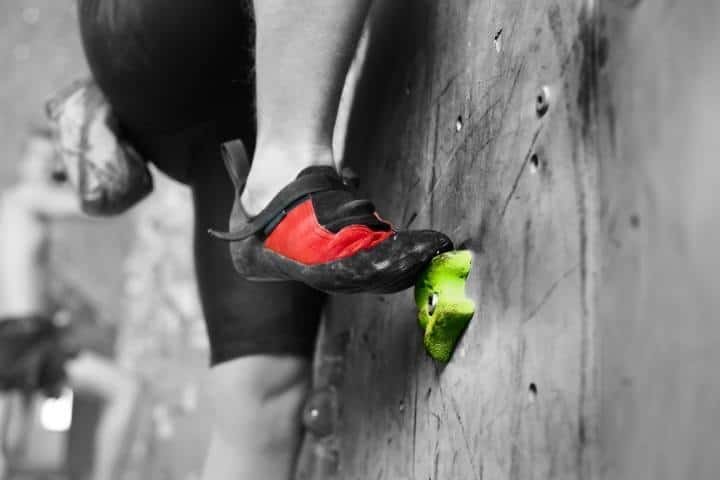Choosing a good pair of climbing shoes, for many, can be akin to choosing which instrument of torture you wish to be tormented with. With so many advocating a super-tight, toe-crunching fit, it seems the only option is to grin and bear it and plump for the lesser of so many evils.
But does this really have to be the case?
Of course not! So, just how should climbing shoes fit? In the following guide, I’ve singled out the most important factors.
How Should Climbing Shoes Fit (Top 6 Factors)
1. Snug, Not Strangling
Though many die-hards recommend going a size down so as to enhance feel and to put their feet in a stronger position on the rock, the ideal fit for your climbing shoes should be snug – any tighter, and not only are you going to take the enjoyment out of it but also risk damaging your feet and, hence, stalling your climbing progress with recovery time.
While a tight-fitting shoe might give you better dexterity, grip and feel on the rock and place your toes in the more powerful crimped position, it may also come at a price. Elite climbers, bless them, are often affected by the following, all of which can lead to lengthy lay-offs:
- Claw or hammer toes
- Bruised toes
- Corns
- Nerve compression
- Fungal infections
- Bunions
2. Toe Fit
Essentially, the ideal shoe fit will leave no dead space or air pockets between your toes and the inside tip of the shoe. Dead space, as you can imagine, tends to bend easily under pressure and so won’t give you nearly as much stability on a small foothold.
But don’t go too far the other way…
If your shoes are so tight that you have to bunch up your toes to get into them, the chances are you’ll not only be mightily uncomfortable when climbing but you’ll also be setting yourself up for an injury.
Additionally, although some climbers buy tight-fitting shoes in order to enhance grip on small holds, this philosophy can easily backfire – resting on a small hold in very tight boots can be agony, and as such you’re more likely to try to get off of it in a hurry!
My Best-Fitting Climbing Shoe:
Last update on 2025-11-28 / Affiliate links / Images from Amazon Product Advertising API
3. Heel fit
As with the toe, the heel fit on your shoe should be snug, without dead space, but not so tight as to crush your Achilles tendon.
Shoes with more aggressive cambers tend to be trickier to get into at the heel and many make the mistake of going a size up and leaving an air pocket at the heel, meaning their feet tend to slip around inside the shoe and they have less grip and feel when performing heel hooks.
Make sure that your shoes fit comfortably around your ankle bone and Achilles tendon – some shoes can sit a little too high in this area and really dig into the bone or tendon, thereby causing a lot of discomfort.
4. Climbing Level and Shoe Type
Knowing your capacities and level as a climber will assist you greatly in finding the ideal fit. Wearing the same shoes as Alex Honnold, sadly, won’t automatically make you climb like Alex Honnold!
Rock climbing shoes types can be broken down into three basic types. Which is right for you will depend largely on the type of climbing you plan on doing and will affect the fit most appropriate to your needs.
Neutral Shoes
These shoes tend to be the most comfortable and suitable for beginner climbers or also trad or multi-pitch climbers who expect to spend a lot of time on the rock without the opportunity to give their feet a breather.
The fairly flat profile makes these shoes good for slots but they are less aggressive in the toe area, generally offer less grip-wise around the heel and less support on very small footholds on steeper climbs.
As it’s less likely you’ll be needing that kind of performance if you are still a beginner, you don’t need to go for the slightly crimped-toed, just-past-snug fit sought by many of the sport’s elite.
[easyazon_cta align=”center” identifier=”B003CULQRG” key=”wide-orange” locale=”US” tag=”advgenesis-20″]
Moderate Shoes
These shoes have a slightly curved camber and can go either way in terms of how tightly they are fitted.
For single-pitch routes or bouldering, you may want to go a fraction tighter in order to give yourself better feel and purchase on small footholds.
For those of you at an intermediate level and doing longer routes, again you can get away with shooting a little towards the side of comfort, with less crimp around the toe.
Aggressive Shoes
The camber on these shoes is even more pronounced than on moderate shoes, with the sole taking on a kind of banana shape that, given a foot’s construction, isn’t ever going to be the most comfortable but is a great help on vertical or overhanging climbs.
Chances are that if you’re climbing at the sort of grade where aggressive shoes are necessary, you’re probably going to want a really snug fit – at that level, every millimeter counts and high-level climbers often opt for a smaller shoe that entails bunching up their toes ever so slightly.
5. Know Thy Enemy (or Climb…)
Know thy enemy and, to a large degree, thou shalt know thy shoe! If you anticipate spending a lot of time cragging, on technical boulder problems, on single pitches or wall-climbing, you can afford to opt for something a little bit ‘pinchy’ as the chances are you will have plenty of opportunities to slip them off and give your feet a breather.
On the other hand, if you tend to do a lot of multi-pitch, trad, or alpine routes, you might want to give yourself, and your toes, a little bit of breathing room. For these types of climb, the fit can afford to be a little looser, without quite so aggressive an arch, toe or heel area, and should be big enough to accommodate a pair of socks on chillier alpine routes.
6. General Fitting Observations
Buying climbing shoes online can be a minefield as sizing can vary widely from one brand to another and even one model to another, so be sure to get into a store and try the shoes on before buying.
Also, make sure you try them on in the afternoon as your feet can increase up to a full size in any given day owing to swelling and the daily gyrations of your venous and lymphatic systems (we’ll spare you the science!).
When trying them on, don’t just stay seated but take the time to move around a little and even try to replicate a few climbing moves as best you can, using stairs, chairs, walls or whatever else you can find. If the store happens to have a little indoor wall, as many do, get on it!
Conclusion
Given that your feet comprise half of your points of contact when climbing, getting the fit of your climbing shoe right is absolutely essential. In addition to helping you avoid the various foot injuries that climbers can succumb to, the fit of your shoe will also determine not only your comfort but also, to a great extent, your performance on the rock.
While there are a number of factors to consider, how your climbing shoes should fit will essentially depend on the type of climbing you plan on doing, your climbing level and, of course, your personal preferences.
That said, the two factors most likely to aid your performance are the bare essentials of comfort and a nice, snug fit – finding a balance between the two will ensure that, whatever your level, your climbing shoes won’t be holding you back.
Top Rated Climbing Shoes
Last update on 2025-11-04 / Affiliate links / Images from Amazon Product Advertising API





